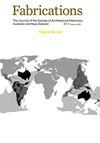Aesthetic Immigrant Environments
IF 0.3
0 ARCHITECTURE
Fabrications-The Journal of the Society of Architectural Historians Australia and New Zealand
Pub Date : 2020-05-03
DOI:10.1080/10331867.2020.1763064
引用次数: 1
Abstract
How can aesthetics be understood from the perspective of the ethnicminority migrant subject or the ethnic-minority migrant community? The mainstream paradigm of migrant settlement is one of deprivation, conditioned by hardships, financial struggles, and bare functionality. But migrant aesthetic production transcends this narrative of thrift and survival. It is underscored by desire and agency, beauty and inspiration. A taxonomy of identifiable migrant architectural types – housing, worship structures, street and retail spaces, gathering spaces – evolving in the migration histories of Australia and New Zealand, as in other settler nations, outlines the interface of migration and aesthetics. This Forum invited these short texts to offer provocations to mainstream aesthetic framing in architecture and its conventional understandings of migrant architecture. A powerful narrative of “remittance” economy frames the discourse on migrant architectural aesthetic production in homeland sites. In The Remittance Landscape, Lopez details structures including sport stadiums and cultural facilities, in addition to housing, that result directly from emigrant economic flows. Images in postcards and magazines, and of iconic structures discovered by migrants are just some of the complex aesthetic sources of this architecture. In contrast, migration studies often assume the aesthetic sources of migrant architecture in destination sites to be homeland vernacular architecture. Singular directional flows of architectural aesthetics are problematic for migrant architecture as for architecture generally. Visibility/invisibilty is important to ethnic-minority migrants, as is the narrative about that visibility. As Lopez illustrates below – a material reference to the homeland and a right to exist and to be visible in the US city – are both part of the objective of using stone transported from Mexico into the United审美移民环境
如何从少数民族移民主体或少数民族移民群体的角度来理解美学?移民安置的主流模式是一种贫困模式,其条件是困难、经济困难和功能匮乏。但移民美学作品超越了这种节俭和生存的叙事。欲望和能动性、美和灵感突出了这一点。与其他定居者国家一样,在澳大利亚和新西兰的移民历史中,可识别的移民建筑类型——住房、礼拜结构、街道和零售空间、聚会空间——的分类法概述了移民与美学的界面。本次论坛邀请了这些简短的文本,以挑衅建筑中的主流美学框架及其对移民建筑的传统理解。一种强有力的“汇款”经济叙事,构成了对移民建筑在本土建筑美学生产的论述。在《汇款景观》中,洛佩兹详细介绍了移民经济流动直接产生的结构,包括体育场馆和文化设施,以及住房。明信片和杂志上的图像,以及移民发现的标志性建筑,只是这座建筑复杂的美学来源之一。相比之下,移民研究往往认为目的地移民建筑的美学来源是本土乡土建筑。建筑美学的单向流动对于移民建筑和一般建筑来说都是有问题的。可见性/不可见性对少数民族移民来说很重要,关于可见性的叙述也是如此。正如洛佩兹在下文中所阐述的那样——对祖国的物质参考以及在美国城市存在和可见的权利——都是使用从墨西哥运到美国的石头的目标的一部分
本文章由计算机程序翻译,如有差异,请以英文原文为准。
求助全文
约1分钟内获得全文
求助全文
来源期刊

CiteScore
0.50
自引率
25.00%
发文量
26
 求助内容:
求助内容: 应助结果提醒方式:
应助结果提醒方式:


